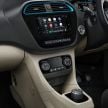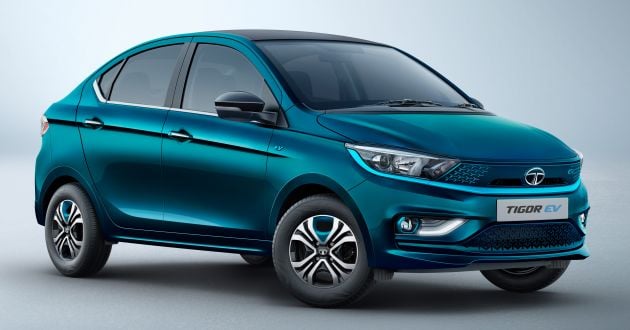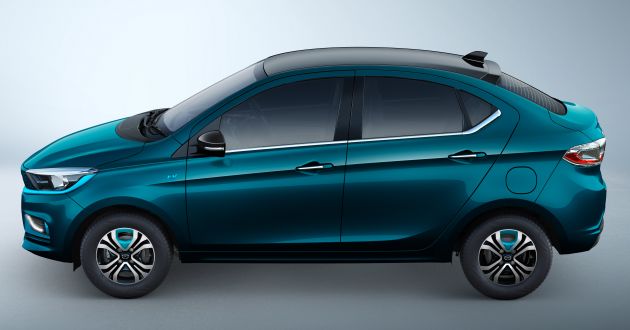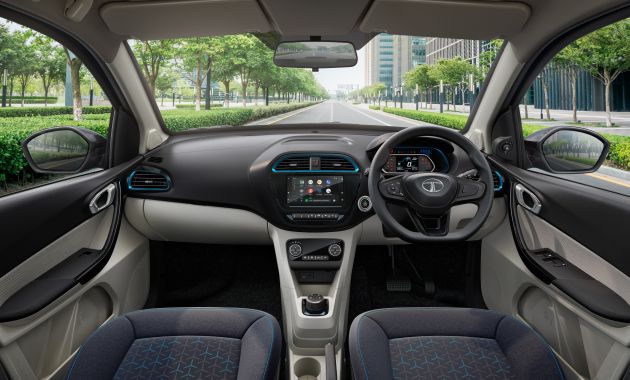Tata Motors has launched the facelifted Tigor EV in India, a few weeks after the model was first revealed in mid-August this year. Essentially a fully electric version of its already-refreshed sedan that competes in the sub-four-metre segment, the Tigor EV is the company’s second electric vehicle available to private buyers and joins the Nexon EV SUV in the local line-up.
Available in three trim levels – XE, XM and XZ+ – pricing for the Tigor EV starts at 1.199 million Indian rupees (RM68,299) and peaks at INR 1.314 million (RM74,850) for the range-topping XZ+ with a two-tone paint scheme.
The low starting price makes the Tigor EV the most affordable EV available to private buyers in India currently, as it even undercuts the Nexon EV that ranges from INR 1.399-1.685 million (RM79,659-95,944).
Highlights of the new Tigor EV include Tata’s Ziptron powertrain that features an electric architecture operating at 300+ volts, which is miles ahead of the previous iteration of the model released in 2019 that was equipped with a 72-volt system.
The setup includes a front e-motor (with a single-speed transmission) providing 75 PS (74 hp or 55 kW) and 170 Nm of torque, which is good enough for the compact sedan to get from rest to 60 km/h in 5.7 seconds. These outputs are superior to the pre-facelift model that only packed 41 PS (40 hp or 30 kW) and 105 Nm.
Powering the e-motor (that also provides regenerative braking) is a liquid-cooled lithium-ion battery pack with an energy capacity of 26 kWh, which is good for an range of 306 km, certified by the Automotive Research Association of India (ARAI). This is, again, an improvement over the 21.5-kWh battery used previously that offered just 213 km of range.
It should be noted that the previous (and lesser) 72-volt system is still used for the commercial version of the Tigor EV called the Xpres-T, which was launched earlier in July. Additionally, the Tigor EV’s powertrain isn’t as capable as the Nexon EV, which offers higher outputs (129 PS and 245 Nm) and slightly more range at 312 km.
For charging, the Tigor EV abandons the previous Bharat EV Charger (BEVC) standard used for both AC and DC fast charging in favour of more conventional connectors. For AC charging, the new model uses the Type 2 standard, and with a 15 A plug point, it’ll take eight hours and 45 minutes to get from a 0-80% state of charge (SoC).



Tata didn’t provide detailed information about the Tigor EV’s AC charging capabilities, but if we extrapolate based on India’s single-phase voltage standard of 230 volts paired with a 15 A point, the vehicle’s onboard charger should theoretically be able to handle up to 3.45 kW of power.
As for DC fast charging, the car uses the CCS2 standard and any DC charger capable of 25 kW will get the battery from a 0-80% SoC in just 65 minutes. Both times beat the previous model’s three-kW AC (11.5 hours from 0-100% SoC) and 15-kW DC (two hours from 0-80% SoC) charging specifications.
Tata says that it has tested the Ziptron powertrain over 35 million km of real-world driving conditions across India’s diverse and challenging landscape, adding that the battery pack and e-motor have an IP67 rating. To further back up the reliability claims, customers will also get an eight-year, 160,000 km warranty on both components.
Compared to the regular internal combustion engine Tigor, the EV model has a closed-off front grille, while the lower intake has smaller apertures – both have a Mercedes-Benz-like mesh pattern on them. The interior is also largely the same, with notable changes being a circular dial for the gear selector and the inclusion of a digital instrument cluster with blue EV accents.
In terms of available equipment, the list includes 14-inch wheels with low rolling resistance 175/65 tyres, projector headlamps, LED DRLs, LED taillights, fog lamps fabric upholstery, automatic air-conditioning, keyless entry and start and a cooled glove box.
For entertainment, the base XE has none, but the XM comes with a 3.5-inch system by Harman and four speakers. Stepping up to the top XZ+ nets you a larger seven-inch touchscreen along with four additional tweeters, Android Auto and Apple CarPlay support, steering-mounted controls and a reverse camera instead of just sensors.
Safety-wise, the vehicle gets two airbags (front passengers), ABS, EBD and electronic stability control, all of which contribute to a four-star safety rating from Global NCAP (GNCAP). The Tigor EV is the first EV ever tested by GNCAP, and it certainly impressed Alejandro Furas, secretary general of Global NCAP, who said, “Tata has shown consistent safety improvements throughout its fleet range.”
“The Tigor demonstrates that improvements are also possible with EV models, which can pose a technical challenge because of the electric powertrain system. Tata should be recognised and applauded for this commitment to improving their vehicles in response to Global NCAP’s call to democratise vehicle safety,” he added.
So, what do you think of this pint-sized EV that is affordable, provides a commendable amount of range, and is deemed safe by an external assessor? Share your thoughts in the comments below.




















The post Tata Tigor EV facelift launched in India – affordable entry-level electric vehicle with 306 km range; fr RM68k appeared first on Paul Tan's Automotive News.




0 Comments